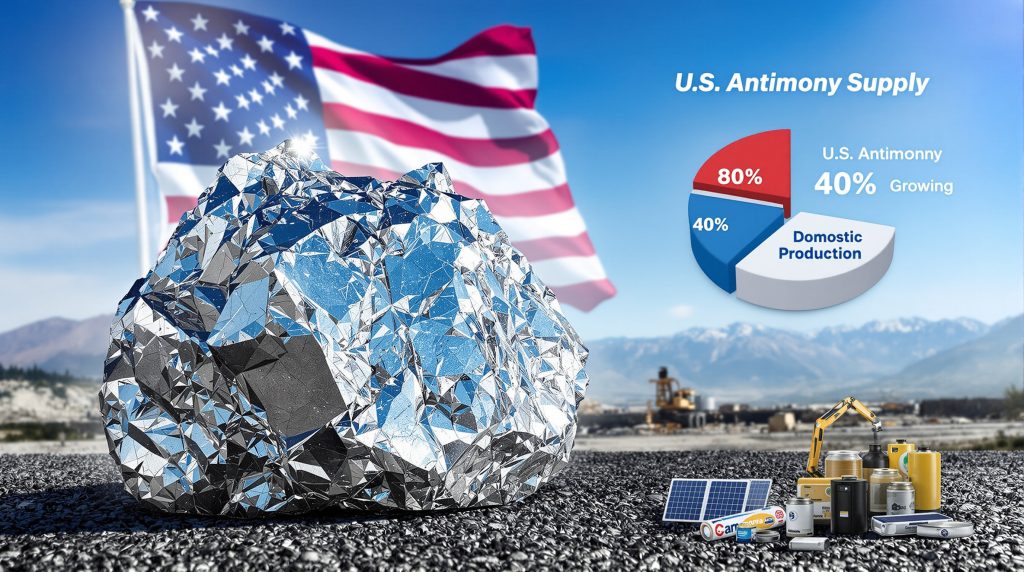Antimony's Strategic Importance to U.S. National Security and Supply Chains
Antimony has emerged as a critical mineral with increasing strategic importance to the United States defense, energy, and technology sectors. This rarely discussed metal has recently gained attention as geopolitical tensions and supply chain vulnerabilities have exposed America's dependence on foreign sources. With China controlling approximately 80% of global antimony production, the U.S. is aggressively pursuing domestic alternatives to secure this vital resource.
Understanding Antimony's Critical Applications
Antimony's unique properties make it indispensable across multiple industries. The metal serves as a flame retardant in numerous applications, including building materials, plastics, and textiles. This property alone accounts for over 60% of antimony consumption globally, helping to prevent countless fire-related casualties and property damage.
In the defense sector, antimony is crucial for manufacturing ammunition, night vision equipment, and infrared detection systems. Military vehicles rely on antimony compounds in their battery systems, and the element helps create harder, more durable lead alloys used in bullets and other ordnance.
The renewable energy transition also depends on antimony, particularly in certain solar panel technologies and energy storage solutions. Grid-scale batteries often incorporate antimony to improve performance and stability, making it an essential component of America's clean energy future.
Semiconductor manufacturing utilizes antimony compounds as dopants, further emphasizing its importance in high-tech industries. Despite these critical applications, the United States currently produces no domestic refined antimony, creating a dangerous supply vulnerability that has caught the attention of national security experts.
Perpetua Resources' Stibnite Gold-Antimony Project
Located in the historic mining district of central Idaho, Perpetua Resources' Stibnite project represents America's best hope for domestic antimony production. The site, approximately 222 kilometers north of Boise, contains an estimated 148 million pounds of antimony alongside 6 million ounces of gold, making it a dual-purpose resource of immense strategic value.
Historical Significance and Modern Potential
The Stibnite area has a rich mining history, particularly during World War II when it provided critical antimony for the Allied war effort. During this period, the site produced more antimony and tungsten than any other U.S. mine, supplying materials vital to military success. Today, the site's redevelopment represents not just a commercial opportunity but a chance to revive America's strategic mineral independence.
When fully operational, the Stibnite project is projected to supply approximately 35-40% of U.S. domestic antimony demand, substantially reducing foreign dependency. This output would represent the single largest contribution to U.S. antimony self-sufficiency in modern history.
Federal Support and Defense Applications
The project's strategic importance has attracted substantial federal attention and support. The U.S. Department of Defense recognized the Stibnite project's national security implications by providing funding under the Defense Production Act Title III program, which focuses on strengthening domestic industrial base capabilities essential for national defense.
This federal backing underscores the Pentagon's concern about defense supply chains. Military applications for antimony include:
- Lead hardening for ammunition
- Infrared sensors and night vision technology
- Battery systems for military vehicles and equipment
- Flame-retardant materials for military uniforms and equipment
The Defense Department's involvement signals a shift in U.S. critical minerals policy toward actively supporting domestic production of critical minerals rather than relying on potentially vulnerable foreign supply chains.
Perpetua's Processing Partnership Developments
While Perpetua Resources plans to mine antimony at the Stibnite site, the company has made a strategic decision to focus on extraction rather than refining. This approach necessitates partnerships with processing experts who can convert the mined antimony into commercially viable products.
Global Trading Companies in Active Negotiations
According to recent announcements, Perpetua is in active discussions with several major global commodity firms about potential antimony processing partnerships. These companies include:
- Glencore: A Swiss-based multinational commodity trading and mining company with extensive experience in metals processing
- Trafigura: One of the world's largest independent commodity traders with significant metals refining operations
- Clarios: A global leader in advanced energy storage solutions and battery technology
- Sunshine Silver: A U.S.-based precious metals mining company exploring expansion into antimony processing
Perpetua CEO Jon Cherry has indicated that the company plans to solicit formal proposals from these potential partners in the coming weeks, with a final partnership decision anticipated by the end of 2025.
Domestic Processing Collaborations Taking Shape
In alignment with the goal of creating a complete domestic supply chain, Perpetua has established preliminary collaborations with U.S.-based processors:
- A non-binding agreement with Sunshine Silver Mining & Refining to assess processing options for antimony from the Stibnite project
- Technical discussions with United States Antimony Corporation, which operates processing facilities in Montana that could potentially refine Stibnite's antimony
These domestic partnerships are particularly significant given that United States Antimony Corporation recently secured a contract worth up to $245 million from the U.S. Defense Logistics Agency to supply antimony metal ingots for defense applications.
Strategic Importance of Processing Partnerships
The partnerships Perpetua is developing represent more than simple business arrangements—they form a crucial component of rebuilding America's critical mineral independence and security.
Creating Complete Domestic Supply Chains
For decades, the United States has allowed critical mineral processing capabilities to migrate overseas, particularly to China. The result has been a dangerous dependency on potentially unreliable foreign sources for materials essential to national security and economic prosperity.
Perpetua's focus on establishing partnerships with both domestic and international processors represents a deliberate strategy to rebuild complete supply chains within U.S. borders. By connecting extraction capabilities with refining and processing expertise, these collaborations aim to create a mine-to-metal ecosystem that reduces vulnerability to foreign supply disruptions.
Industry experts note that rebuilding processing capabilities is often more challenging than establishing mining operations, as the technical expertise has largely disappeared from the American industrial base. These partnerships help bridge that knowledge gap.
Responding to China's Export Restrictions
The timing of Perpetua's partnership development has gained additional urgency due to China's recent decision to restrict antimony exports to the United States. This trade action has exposed the vulnerability of U.S. supply chains and accelerated efforts to establish domestic alternatives.
The Chinese export restrictions affect multiple forms of antimony, including:
- Antimony oxide, used in flame retardants
- Antimony metal, used in alloys and ammunition
- Antimony sulfide, used in batteries and electronics
With these supply channels constrained, the partnerships being developed by Perpetua represent a critical path to supply chain resilience for essential applications in defense and energy technologies.
Perpetua's Development Timeline
Perpetua Resources is following a methodical development timeline designed to bring the Stibnite project online as efficiently as possible while navigating the necessary regulatory processes.
Regulatory Progress and Construction Schedule
The company reached a significant milestone in September 2025 when it received permission from the U.S. government to begin construction of its antimony and gold mine. This regulatory approval came after extensive environmental review and public comment periods.
Perpetua anticipates receiving all necessary project permits by year-end 2025, with construction commencing shortly thereafter. The timeline for processing partnerships aligns with this development schedule, with partnership decisions expected before construction begins to ensure seamless integration between mining and refining operations.
The construction phase is expected to last approximately 3-4 years, with initial production targeted for 2029-2030, though this timeline could accelerate if processing partnerships enable more efficient development.
Production and Processing Capacity Goals
While final engineering designs are still being optimized, the Stibnite project has established preliminary production targets:
- Annual antimony production: 5-7 million pounds
- Processing recovery rate: Targeted at 85-90%
- Product specifications: Multiple grades for different applications
- Market focus: Defense, energy storage, and flame retardant sectors
The processing partnerships being developed will significantly influence these parameters, as different refining technologies and expertise could enhance recovery rates and product specifications.
Project Challenges and Solutions
Despite its strategic importance, the Stibnite project faces several significant challenges that Perpetua must navigate successfully.
Environmental and Community Considerations
The project has encountered opposition from some environmental groups and local tribes. Idaho's Nez Perce tribe has expressed particular concerns about potential impacts on salmon populations in nearby waterways, leading to legal challenges that could affect the project timeline.
Perpetua has responded with a comprehensive plan that emphasizes environmental restoration alongside resource development. The company's approach includes:
- Restoring fish passage that has been blocked by historical mining activities
- Removing and reprocessing millions of tons of legacy tailings
- Improving water quality by addressing historical pollution sources
- Implementing state-of-the-art water management systems
The company maintains that the project will result in a net environmental improvement, as it includes restoration of historical mining impacts that predate modern environmental regulations.
Technical Processing Challenges
Developing domestic antimony processing capabilities presents technical challenges beyond the mining operation itself. The United States has largely lost its expertise in antimony refining as production shifted overseas in recent decades.
Specific technical challenges include:
- Optimizing recovery rates from Stibnite's unique ore composition
- Developing processing methods that meet stringent environmental standards
- Training a workforce skilled in antimony metallurgy
- Establishing quality control systems for defense-grade antimony products
The partnerships being pursued aim to address these technical gaps by leveraging both domestic and international expertise in antimony refining and processing.
Integration with U.S. Critical Minerals Strategy
Perpetua's antimony project represents one component of a broader national effort to secure domestic supply chains for materials deemed critical to national security and economic prosperity.
Alignment with National Security Priorities
The project aligns directly with priorities established in the U.S. defense minerals strategy, which identifies antimony as one of several materials requiring urgent supply chain diversification. The Defense Production Act funding received by Perpetua exemplifies this strategic alignment, positioning the Stibnite project as a cornerstone of national security mineral supply.
Beyond direct funding, the project benefits from:
- Expedited permitting under critical infrastructure designations
- Inter-agency coordination to address regulatory hurdles
- National security classification for certain aspects of the operation
- Technical support from national laboratories and defense research agencies
These advantages reflect the project's importance within the broader framework of American mineral security policy.
Comparison to Other U.S. Critical Mineral Initiatives
The Perpetua Resources antimony processing partnership represents one part of a larger national effort to reduce dependency on foreign sources of critical minerals. Similar initiatives are underway for:
- Rare earth elements: Essential for magnets in defense systems and renewable energy
- Lithium: Critical for electric vehicle batteries and grid storage
- Cobalt and nickel: Key components in advanced battery technologies
- Gallium and germanium: Vital for semiconductor manufacturing
When viewed collectively, these efforts represent a fundamental restructuring of America's approach to mineral security, shifting from globalized supply chains to more resilient domestic alternatives.
Future Impact on U.S. Antimony Supply
The successful development of the Stibnite project and its associated processing partnerships would dramatically reshape America's antimony supply landscape.
Projected Impact on Domestic Self-Sufficiency
Once operational, the Stibnite project could supply up to 40% of U.S. domestic antimony demand, representing a transformational reduction in foreign dependency. This shift would significantly enhance supply security for critical applications while potentially stabilizing prices for American manufacturers.
The remaining 60% of demand would still require imports, but diversification of suppliers beyond China would create additional resilience. Potential alternative sources include:
- Australia: Developing antimony projects with potential future production
- Canada: Several exploration projects targeting antimony resources
- Turkey: Existing production with potential for expansion
- Mexico: Historical production that could be revitalized with modern techniques
A balanced approach combining domestic production with diverse international partnerships would create the most resilient supply chain structure.
Market Implications for Antimony Consumers
U.S. manufacturers who rely on antimony stand to benefit significantly from the development of domestic supply chains. Industries potentially affected include:
- Defense contractors producing ammunition and military equipment
- Battery manufacturers developing next-generation energy storage
- Building materials companies producing flame-retardant products
- Electronics manufacturers requiring antimony-based semiconductor materials
These sectors currently face significant supply uncertainty and price volatility due to dependency on Chinese exports. Domestic production would provide more stable pricing, shorter supply chains, and reduced geopolitical risk.
FAQs About Perpetua's Antimony Processing Partnerships
What is the current status of U.S. antimony production?
The United States currently has no primary antimony production, with the last significant domestic output occurring decades ago. The country relies almost entirely on imports, primarily from China, which controls approximately 80% of global antimony supply. Some limited secondary recovery occurs from recycled lead-acid batteries, but this represents a small fraction of total demand.
United States Antimony Corporation operates processing facilities in Montana, but these currently rely on imported feed materials rather than domestic ore. The company's recent $245 million contract with the Defense Logistics Agency highlights the urgent need for domestic antimony sources.
How will these partnerships affect antimony prices?
While specific price impacts remain uncertain, developing domestic supply chains could potentially stabilize prices for U.S. consumers by reducing dependency on volatile international markets. Antimony price surge has historically experienced significant fluctuations based on Chinese export policies, with price swings of 30-50% not uncommon during periods of supply constraint.
Domestic production would provide a price floor and ceiling effect, moderating extreme volatility while ensuring competitive market dynamics. Industries requiring long-term planning horizons, such as defense contractors and battery manufacturers, would benefit particularly from this price stability.
What are the primary applications for antimony in the U.S.?
Antimony serves several critical functions across multiple industries:
- Flame retardants (60-65% of consumption): Used in plastics, textiles, and building materials
- Lead-acid batteries (15-20%): Improves charging characteristics and battery life
- Ammunition and ordnance (5-10%): Hardens lead for improved performance
- Semiconductors and electronics (3-5%): Functions as a dopant in certain applications
- Glass and ceramics (2-3%): Provides clarity and specific optical properties
- Emerging technologies (5%): Including next-generation solar panels and grid storage
Defense applications span multiple categories, making the total military-related consumption difficult to precisely quantify but estimated at approximately 20-25% of total U.S. demand.
How does the Stibnite project compare to international antimony sources?
While the Stibnite project won't match the production scale of the largest Chinese operations, it represents a significant domestic resource with several advantages:
| Aspect | Stibnite Project | Chinese Mines | Other International Sources |
|---|---|---|---|
| Annual Production Potential | 5-7 million pounds | 10-20+ million pounds (individual large mines) | 1-5 million pounds (typical) |
| Ore Grade | Medium to high | Variable (declining in many regions) | Typically lower grade |
| Regulatory Oversight | Stringent U.S. standards | Variable enforcement | Depends on jurisdiction |
| Environmental Practices | Modern standards with restoration component | Often below international standards | Variable by country |
| Labour Practices | U.S. labour laws | Often problematic | Variable by country |
| By-product Value | Significant gold content | Often lower value by-products | Variable |
The project's estimated 148 million pounds of antimony reserves make it globally significant despite not being the world's largest deposit. Its location within U.S. borders provides security advantages that outweigh pure production volume considerations.
Building a Resilient Antimony Future
The development of Perpetua's Stibnite project and its associated strategic antimony loan represents a critical step toward American mineral independence. By addressing both extraction and refining capabilities, these initiatives aim to rebuild complete supply chains for a material essential to national security and economic prosperity.
While challenges remain, the clear strategic importance of antimony and strong government support suggest a path forward for this vital project. As global mineral competition intensifies, securing domestic sources of critical materials like antimony will only grow more important to America's industrial and defense capabilities.
Stakeholders across government, industry, and communities must collaborate to balance environmental protection with resource development, ensuring that projects like Stibnite can proceed in ways that benefit both national security and local ecosystems. With thoughtful development and strong partnerships, the U.S. can significantly reduce its vulnerability to antimony supply disruptions while creating jobs and economic opportunity in mining communities.
Want to Catch the Next Major Mineral Discovery?
Discover why strategic minerals like antimony can create exceptional investment returns by exploring Discovery Alert's dedicated discoveries page, where our proprietary Discovery IQ model delivers real-time alerts on significant ASX mineral discoveries, empowering you to identify actionable opportunities ahead of the broader market. Begin your 30-day free trial today at https://discoveryalert.com.au/discoveries/.




